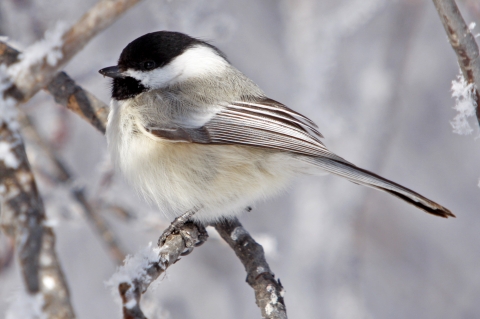At Minnesota Valley's Old Cedar Avenue trailhead, where mosquitoes zig-zagged through the tall grasses, softshell turtles slid through the mud and toads leapt along the trail’s edge all summer, November brings a stillness to the wetlands that's hard to ignore. As a morning frost replaces the dew, you might have noticed our insect, reptile and amphibian populations waning. If you’re anything like me, you might be wondering, where do all our cold-blooded friends go in winter?
Survival Strategies
Different animals have adapted different strategies to survive (or flee from) Minnesota’s harsh winters. Some birds and insects, like wood ducks and monarch butterflies, migrate to warmer climates at the first signs of fall. However, many animals have adapted to Minnesota’s climate in fascinating ways. The birds that overwinter here, like cardinals and chickadees, grow extra winter feathers, nearly doubling the number of feathers on their bodies! Several mammals also grow winter coats. Some animals, however, need more than just a coat to withstand the weather. Due to a greatly decreased food supply in winter, some animals must undergo serious physiological changes to withstand the weather, and this is especially true for our cold-blooded friends.
Sleeping Through It
While most people have heard of hibernation as a winter survival strategy, did you know that there’s more than one kind of winter slumber? Turtles, frogs, toads, snakes and many insects spend winter in a state of decreased activity called torpor. Torpor, the umbrella term that includes hibernation, brumation and estivation, is a temporary state of lowered metabolism and body temperature that many animals enter during extreme temperature conditions.
Hibernation, utilized by many Minnesota mammals, is the best-known torpor variation, made famous by the iconic Pennsylvania groundhog, Punxsutawney Phil. But other animals use shorter forms of torpor for different purposes. Reptiles and amphibians enter a torpor state known as “brumation,” which differs from hibernation mainly in length. While hibernating animals like bears store fat for the winter, reptiles and amphibians often don’t have enough available fat reserves to last the entire winter. Instead, brumating animals actually eat less before entering periods of brumation, as their metabolic rate drops so low that they can’t digest anything. Brumation allows ectotherms to use extremely small amounts of energy to survive. But, due to its temporary nature, if the weather warms up for a brief period of time, these animals could awaken from their lethargic slumber and forage until the next frost. Insects are among the group of animals that also undergo a state of flexible torpor.
Glycol: Nature’s Antifreeze
But, you may be wondering, how do cold-blooded animals avoid freezing solid? Reptiles, amphibians, fish and many insects, including houseflies, dragonflies, mayflies and stoneflies, undergo a process called “cold hardening.” This process involves the conversion of their blood into a cryoprotectant, an alcohol called glycol, which prevents ice crystals from forming in their bodies. Not all cold-hardening animals specifically produce glycol, but glycol is the most common cryoprotectant. If you happen to come across a frozen frog or fly, don’t fear! Move them off the trail, and come spring, they will leap back to life.
Winter Survivors
Though many of our scaly friends have fled the scene, there’s still plenty of wildlife to see on our refuge! As snow begins to fall, watch out for tracks and scat of deer, rabbits, foxes and raccoons. Keep an eye out for changelings, too. Short and long-tailed weasels, too, don a winter coat and a new winter name: ermines. Come see for yourself! Take a trip to the refuge this snowy season. Many of Minnesota Valley’s trails are maintained through the winter, and we encourage you to stay warm outside by getting your heart rate up and exploring! Feel free to swing by the information desk at the Bloomington Visitor Center during open hours to check out snowshoes for free and our staff can help to orient you for a winter hike.
We hope to see you here soon!







